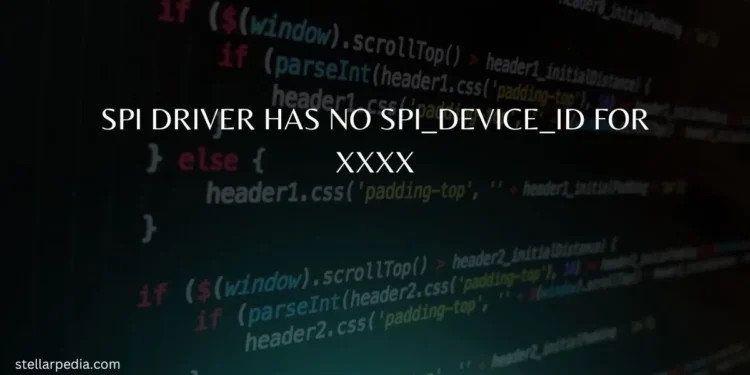Serial Peripheral Interface (SPI) is a popular synchronous serial communication protocol used to transfer data between a master device and one or more peripheral devices. In embedded systems and microcontroller applications, SPI drivers play a crucial role in managing these communications. However, developers often encounter a common issue where the SPI driver has no spi_device_id for a specific device, denoted as xxxx in error messages. This article delves into the causes, troubleshooting steps, and solutions for this issue.
Understanding SPI and SPI Drivers
What is SPI?
SPI is a full-duplex communication protocol that operates with a master-slave architecture. It involves four main signals:
- MOSI (Master Out Slave In): Data line for master to send data to the slave.
- MISO (Master In Slave Out): Data line for the slave to send data to the master.
- SCLK (Serial Clock): Clock signal generated by the master to synchronize data transmission.
- SS (Slave Select): Line used by the master to select a specific slave for communication.
Role of SPI Drivers
SPI drivers in the Linux kernel or other operating systems are responsible for:
- Managing the SPI bus and ensuring proper communication between master and slave devices.
- Providing a standard interface for communication.
- Handling the configuration and initialization of SPI devices.
The Issue: SPI Driver Has No spi_device_id for XXXX
What Does the Error Mean?
The error “SPI driver has no spi_device_id for xxxx” typically indicates that the SPI driver does not recognize or support the specific device identified by xxxx. This can occur during device probing, where the kernel tries to match the connected hardware with a compatible driver.
Common Causes
- Missing Device ID in Driver Code: The driver code does not include the device ID of the specific SPI device.
- Incorrect Device Tree Configuration: The device tree blob (DTB) used in the system does not properly describe the SPI device.
- Driver Mismatch: The wrong driver is being used for the connected SPI device.
- Kernel Version Compatibility: The kernel version might not support the specific SPI device.
Troubleshooting Steps
Step 1: Verify Device Tree Configuration
The device tree is a data structure for describing the hardware components of a system. Ensure that the device tree includes an entry for the SPI device.
Example device tree snippet:
dtsCopy code&spi0 {
status = "okay";
device@0 {
compatible = "vendor,device";
reg = <0>;
spi-max-frequency = <50000000>;
};
};
Check the compatible property and ensure it matches the expected device ID format.
Step 2: Check Driver Code for spi_device_id Table
In the driver source code, there should be an spi_device_id table that lists supported devices. Example:
cCopy codestatic const struct spi_device_id my_spi_device_id[] = {
{ "xxxx", 0 },
{ }
};
MODULE_DEVICE_TABLE(spi, my_spi_device_id);
Ensure that the device ID xxxx is listed.
Step 3: Update Kernel or Driver
If the driver does not support the device, consider updating the kernel or the SPI driver to a newer version that includes support for xxxx. This might involve:
- Downloading and compiling a newer kernel version.
- Patching the existing driver to add support for the new device.
Step 4: Verify SPI Bus Configuration
Ensure that the SPI bus is correctly configured in the system:
- Check the SPI master controller configuration.
- Verify the SPI clock speed and other parameters.
Resolving the Issue
Adding Device ID to the Driver
If the device ID is missing from the driver, you can add it manually:
- Locate the driver source code file.
- Add the device ID to the
spi_device_idtable. - Recompile the driver and load it into the kernel.
Example modification:
cCopy codestatic const struct spi_device_id my_spi_device_id[] = {
{ "xxxx", 0 }, // Add this line
{ }
};
MODULE_DEVICE_TABLE(spi, my_spi_device_id);
Correcting the Device Tree
Ensure the device tree accurately describes the SPI device and uses the correct compatible string:
dtsCopy code&spi0 {
status = "okay";
xxxx@0 {
compatible = "vendor,xxxx";
reg = <0>;
spi-max-frequency = <50000000>;
};
};
Updating Kernel or Driver
To update the kernel or driver:
- Obtain the Latest Kernel Source: Download from the official repository or your hardware vendor.
- Apply Necessary Patches: If specific patches are required for your SPI device, apply them.
- Recompile the Kernel: Follow your system’s guidelines to recompile and install the kernel.
Ensuring Compatibility
Verify that your SPI device and driver are compatible with your system’s architecture and kernel version. Sometimes, compatibility issues arise from using outdated or incompatible hardware and software combinations.
Conclusion
The “SPI driver has no spi_device_id for xxxx” error can be a hurdle in embedded system development, but understanding its causes and following systematic troubleshooting steps can resolve the issue. Ensuring proper device tree configuration, updating driver code, and maintaining kernel compatibility are crucial. By addressing these areas, developers can ensure seamless SPI communication and device integration in their projects.



